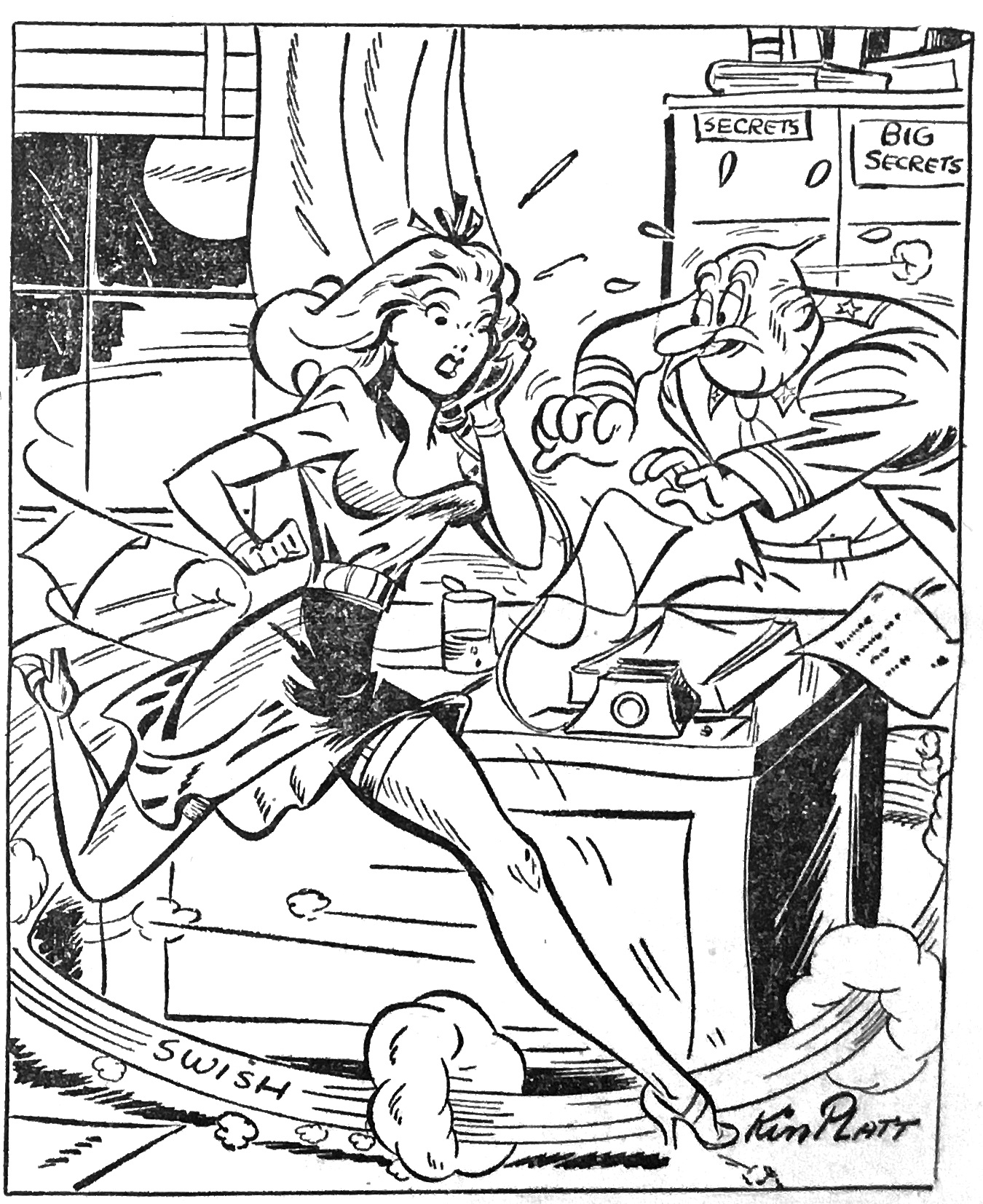
Vol. 1, No. 3 Published by India China Division, Air Transport Command Feb. 1, 1945
SUPPLIES FLOWN TO CHINA COMMUNISTS
|
ICD Carries First Red Cross
Medical Goods to Yenan, Seat
Of the Communist Government
In Shipment; ‘More Than I've Seen in
Eight Years,’ Dr. Ma Observes
HQ., CHINA WING, KUNMING - For the first time, American Red Cross medical supplies have been flown to Chinese Communist headquarters.
Planes of ICD's China Wing carried the medicines by air to the remote and isolated seat of the Communists at Yenan. Included in the shipments were sulfa drugs, microscopes, X-ray equipment, surgical instruments and other medical supplies.
The supplies were delivered for the Bethune Memorial International Peace hospital, over which Dr. Ma Hai-teh presides at Yenan. He called the first airplane load to arrive "more medicine than I've seen in the last eight years put together." Dr. Ma, an American from North Carolina who prefers to be known by his Chinese name, has been with the Communists, both in the field and at their base hospitals, ever since his arrival in China in 1937.
Many Contribute
Medicines involved were collected through the co-operation of the Chinese Central government, various agencies of which released part of the supply they had received from the American Red Cross. Transfer of them was approved by Central government authorities.
The agencies which turned over part of their Red Cross-donated medical supplies were the National Health administration; Ministry of Education; International Relief committees and the Chinese Red Cross, all of whom have received supplies regularly from the American Red Cross.
The supplies will be used to treat civilians as well as Communist soldiers injured in battle against the Japanese. A part of them will remain at Yenan, while will be carried across several Japanese lines to field hospitals in the northeastern part of China, far behind Japanese dominated areas.
Hospital in Caves
From Yenan on, the mule and the coolie will take over the job thus far carried out by ATC planes. Instead of hours, weeks will be required.
The hospital in Yenan, like almost all installations there, both offices and quarters, is in a series of caves. Leveled by the Japanese in 1939, the old city still is a mass of rubble. The caves provide bomb-proof shelter and are relatively warm in a cold land where fuel is scarce.
First flight of medicines to Yenan was made by Lt. Col. Floyd H. Davidson, Atherton, Calif., and Maj. Thomas D. Park, Dallas, Tex., ICD officers and both former airline pilots with years of flying experience. This experience stood them in good stead, for the last leg of the flight was made over miles of hills with the sameness of the sea. There are no landmarks, save one pagoda at Yenan, and that can be seen only for a short distance. Navigational aids to aircraft of course, do not exist. The short runway is in the bottom of a narrow valley.
Starting in Yunnan province, the flight is a long one with bad weather increasing on the trip's last leg, over mountains towering thousands of feet into the clouds. Bucking ice and topping the clouds, a C-47 carried the medicines safely through, under the skillful piloting of Lt. Col. Davidson and Maj. Park. Crew members on the trip were S/Sgt. Tommy H. Eldridge, Dunn, La., radio operator and Cpl. Vander S. Morrison, Midland, N.C., engineer.
|
Rescue Group Achieves Base Unit Standing
Saving of Downed Airmen Gets Shot in Arm in New Setup
Bringing out downed airmen from the almost inaccessible Himalaya mountain region has become such a prominent part of ICD's operations that the Search and Rescue squadron has been activated to full base unit status.
The new organization is known as the 1352nd and will be located at the 1332nd Base Unit. It is commanded by Maj. Donald C. Pricer. Assigned in India for almost two years, he has been a pilot, operations officer and an executive. Maj. Roland L. Hedrick will continue with the new unit as intelligence officer.
Safety Factor
The unit will share part of the facilities of the 1332nd but will be complete within itself. Its assigned aircraft will include armed B-25s, C-47s for cargo dropping, and L-5s for evacuation and rescue from tiny airstrips in jungles and mountains.
Two main reasons are given for the formal activation of the 1352nd. First, increasing Hump traffic has necessitated greater facilities for rescue work. Second, past developments have proved that organized effort to bring back downed airmen is effective and necessary.
Records show that those who bail out over the Hump or in the trackless Assam jungles now have a better than three-to-one chance of returning safely. But it wasn't always thus.
Like Country Store
Previous to October, 1943, rescue activities were sporadic and unorganized. Each station hunted for its own planes and pilots. Jungle tribes were unknown and believed to be headhunters, fiercely quarrelsome and war-like. Experience has proved this untrue.
The search and rescue group soon established liaison with British Territorial officials and American missionaries who knew the jungle and mountain people.
By trial and error the organization grew until it had its own warehouses, aircraft and intelligence unit - everything needed to permit maximum aid to luckless airmen who hit the silk. Today, the 1352nd's warehouses look like a country store. Blankets, clothing, Bibles, and trinkets for barter line the shelves.
When an aircraft from any command reports trouble the unit springs into action. Once a fix is obtained on the probable position of the distressed ship, search planes take off. When the crashed craft is spotted and if survivors appear to be on the scene, panels for communication are dropped. Physical condition of crew members is checked by the panel method, and if necessary a volunteer flight surgeon parachutes with medicine. Supplies and maps are dropped, directing the party out by easy stages, with instructions as to previously spotted food caches.
Some airmen are brought by L-5s, from tiny strips hacked from the jungle or perched on a mountainside, but most walk out - some taking as long as three months. Still others have shot the rapids in native rafts and canoes, to return to their station and again take on the job of flying the Hump.
Rotation? Leaves? Mess? Just Ask Morale Boards
Promotions, furloughs, housing and mess facilities - and, of course, always in the foreground, rotation policy - all have had to stand the test before the recently created morale boards.
Effects of the morale program is evidenced by December reports in which almost half of the bases reported morale among their soldiers as "very high."
It always has been realized that morale could not just be turned on or off. Thorough studies of conditions constructive criticism and recommendations for remediable measures were the lines along which the program had to be built.
Handle Individual Gripes
Early in October morale boards were established at each base in the division. Each board consists of seven officers. Generally they include the surgeon, chaplain, administrative inspector, and special service, supply and service, intelligence and security and public relations officers.
These bodies meet twice each month to discuss housing, messes, medical care, recreational facilities and other matters which affect morale. They gather their information from soldier councils, individual "gripes" and first hand information.
The boards make recommendations to the COs for action to remedy any particular gripes.
Rotation in Foreground
Recently the rest camp situation has been improved. Laundry facilities have been put under GI supervision in many places to bring up standards. Promotions have been upped and special service activities and recreational facilities, expanded.
Rotation has been in the foreground since the establishment of the boards. A general policy has been announced and will be followed as closely as possible.
|
Dyeing Rats Isn't His Business, But He Does Good Job 1333rd BU, ASSAM - If you see a pink elephant, blame it on your brand of liquor, but if a blue rat runs across your tent it's the fault of T/Sgt. Thomas H. Maras, a draftsman in the rescue intelligence office here. The rat received its new color one day when Sgt. Maras, of Highland Park, Mich., was cleaning termites out of a filing cabinet. As the cabinet was moved, the rat appeared. Capt. John E. Albert, intelligence officer, covered the left flank with a crowbar and Sgt. Maras stood on the right with a raised axe. The rat chose to run to the right, and the sergeant swung. The axe came down on a quart of blue ink, which splashed all over the office, on the sergeant's clothes and on the rat. The latter escaped, whistling "Am I Blue?" |
|
1330th Sets Valley, Base Records for 24 Hours of Flight 1330th BU, ASSAM - Tojo took a new licking at the hands of the 1330th's Humpsters this week when the base established new field and valley records for four-engine trips over the rock heap. For two consecutive days the record-busting went on. The achievement for one 24-hour period showed that the boys exceeded their own field record by 11 trips and the entire valley record by ten. But what really scored was the fact that the last plane out to establish the new figure was the oldest crate on the field, and was making its third trip into China that day! |
|
Merry Christmas Comes a Bit Late to GI at 1302nd IW HQ, DELHI - When the GI mailman handed Sgt. John Mullarkey a package from the States, the latter was pretty happy about it. Four weeks past Christmas, to be sure - but better late than never, decided the sergeant. As he ripped off the inner wrappings of bright paper, he let out a startled yell. The fruit cake and peanut-candy inside the box were the worst mess of dried up sweets and rancid nuts he had ever seen. Then his eyes hit on the postmark - Oct. 15, 1943 ! It was a Christmas package all right, but for the wrong Christmas. The present, mailed by Mrs. Algie Ward from Chicago, had been sent to Sgt. Mullarkey's temporary APO and for the last 15 months had trailed him as he transferred to different bases. In all, the box had crossed India three times. |
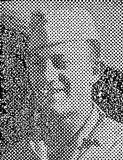
|
Tells Katz Sister Is Well
1348th BU, NORTH BURMA - From GIs in France to a GI in Burma have come two V-mail letters carrying the first cheering news in eight months about the youngest sister of Pfc. Ernest Katz, German-born GI who works in the orderly room at this base.
The letters were written by ETO soldiers Marvin Saltzburg and Richard H. Arnold, who had met Katz's 21-year-old sister, Laure, on separate occasions, and wrote brief messages advising him that she was well. To the Burma GI it was the end of a nerve-racking period of worry.
Laure and Ernest have a brother, T/Sgt. William Katz, who was in North Africa, Sicily and on the Anzio beachhead and a brother-in-law who served on Guam and more recently went ashore with the infantry at Leyte.
In '36 Ernest left Nazi-ridden Germany with another sister and made his way to America. Two years later, another sister and a brother followed, but their parents and youngest sister, Laure, remained in Germany. One day in October, 1940, Ernest Katz picked up a copy of the New York Times and read that all Jews in his native Palatinate and those in Badenia were being sent to concentration camps in unoccupied France. Ten days later, a telegram confirmed the tragic news.
The barbarous treatment received by internees in the camps soon resulted in another telegram telling of the death of Katz's mother - due, he later learned, to malnutrition. While his father and sister, Laure, suffered the inhumanities of life under Nazidom, Katz and his relatives in the States were trying to arrange passage for the pair. But then came the invasion of North Africa in 1942, and France was totally occupied by the Germans.
From then on, Katz communicated with his sister through the Red Cross. Strict censorship limited his letters to 25 words, and mail arrived at six-month intervals. After a short internment, Laure was released from the camp, but the father was sent to a hospital in Perpignon, and eventually to Poland. He never has been heard from since.
Some friendly nuns sheltered the young Jewish refugee girl and she found work as a child's nurse in Lyons. From her meager earnings she managed to buy bread and send it to her sick father as long as her contacts with him existed. The nuns were a constant source of help and guidance to the victim of intolerance. Then came, at last, the invasion of southern France, and the arrival of the GIs - among them Saltzburg and Arnold who have eased Katz's mind with their reports that his sister is well.
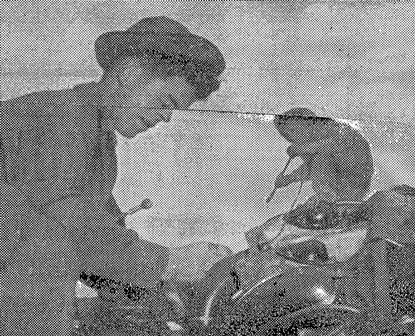 Junior (right) and Cpl. George Hanei at work on one of their assignments as mobile engine-change crew members. Junior doesn't malum the fine points yet,
but the keen interest in her work displayed here, and great natural ability, will undoubtedly carry her on to fulfilment of her ambition to be a real grease
monkey.
Junior (right) and Cpl. George Hanei at work on one of their assignments as mobile engine-change crew members. Junior doesn't malum the fine points yet,
but the keen interest in her work displayed here, and great natural ability, will undoubtedly carry her on to fulfilment of her ambition to be a real grease
monkey.
|
Engine Change Crew
Sets Up Record Mark
Claims Share of Credit
By local standards - taking into account the hardly favorable conditions faced by understaffed teams here - the achievement is remarkable.
"Junior," the crew's monkey mascot whose name belies her sex, chatteringly claims her full share of the credit. Junior was adopted by Cpl. George Hanei, member of the team, back in India when she was only three weeks old. She has a natural affinity for monkey wrenches and makes a pass at every one within reach. Hanei keeps her from throwing a wrench into the delicate vitals of Hump aircraft by locking her up in the plane's cabin while he works.
"But she's made up her mind," he says, "that by hook or crook she's going to be a grease monkey."
No place for softies, mobile engine change is packed with glamor and unforeseen adventure. Here, today, the crew may be off tomorrow on a special job to any of the remote China bases. It's usually pretty rough when the boys are on these missions, too. They sleep in the plane, eat out of mess gear, and work under primitive conditions, ordinarily without crew-chief stands or portable hoists. One crew was initiated in the tense, dramatic ordeal of having to bail out of a burning ship.
The record-breaking crew spent New Year's in Burma, only 30 miles from Jap lines, in country still scarred by the ravages of jungle warfare. They brought back all sorts of Jap souvenirs. "We'd have taken some Jap teeth," says Cpl. Tommy Abraham, "only the bodies were too messy."
As a whole the mobile engine change boys were relieved to get to a warm climate again. It was a real treat for Junior. Hanei says she had a regular field day, hopping from tree to tree, and scrambling up the vines of her natural jungle habitat. She even went swimming with the men.
ATC Personnel Gets Back-pat From ‘Hap’ Arnold;
Envisions Postwar World Air Transport
Recognizes Contribution of Men Serving at Isolated Outposts
Gen. "Hap" Arnold, in a recent letter, called attention to ATC's pioneering of world air routes, its far-flung operations and the knowledge and experience being piled up to benefit post-war airways systems.
Addressed to Gen. H. L. George, commander of the ATC, and brought to the attention of all its personnel, the communication read:
"The impressive body of knowledge and experience that is being stored up every day by the ATC is bound to result in enormous benefit to our post-war air transportation program. The methods, routes, and techniques developed under the extraordinary stresses of present-day war, when blended with the technical progress achieved by the designers and manufacturers of our aircraft, will inevitably shorten the distances which today separate one nation from another. The ATC is certainly keeping pace with the great successes of the entire AAF in this fight."
Gen. Arnold also commented on the world-wide operations of ATC, with these words:
"From its first fledgling hopes to the smoothly-run intricate operation it has become during the last year, the Air Transport Command has come a long way. Our combat air forces are accustomed to consider themselves widely traveled, but many out-of-the-way corners of the earth which have remained completely unaffected by the war have come to know the pilots and planes of the ATC."
The letter recognized the contributions of the "men who fly long, hard runs with valuable cargoes of men and supplies and those who man the way-stations some of which are so remote and isolated that their names are all but unknown even to the inhabitants of the countries in which they are located." (Editor's note: What's he talking about; Assam, Burma or China?)
Longs for ‘Boom’ of Big Cannon in Field Artillery
By CPL. FRANK CLARK
1345th BU, INDIA - This is a story which could be fabled "Ode to the Boom-Booms" or "I Shoulda Stood in Ft. Sill" - as it concerns a man, who, for "security" reasons must remain nameless, and who is quite angry with the powers that be for taking him out of the artillery and putting him in the AAF. By his own admission, that boy certainly liked the big guns.
It seems that at one time, this man, like a few million others, received the note from Uncle Sam, reported for duty and promptly was snapped up by the artillery.
He became quite attached to the big guns - said he liked the way the earth would tremble when they went off. Perhaps he listened to too many go "boom" and sort of went "boom" himself, but that's another story.
Over a period of time he was shifted from one post to another, receiving all sorts of training on the big guns, until he could "knock the beads of sweat off a first sergeant's brow at seven miles."
Naturally, a man with his potentialities would be wasting his time in the States, so his outfit, big guns and all, was loaded on a boat and shipped overseas. He was in transit for some time, passing all the places where he thought the outfit would be needed most, until one day the boat docked in India. Like countless other GIs, newly arrived in India, he said, "Well, it could be worse, but where?"
The men unloaded themselves and their big guns, then proceeded to sit around the docks and wonder, "Where do we go from here?"
Unfortunately there didn't seem to be any place to send artillerymen in India, and this is where the five fickle fingers of fate fashioned themselves into an iron hand and hauled the whole gang into the Air Corps, which needed personnel.
This man isn't happy! He is driving a truck and no longer hears the big guns go "boom" nor does he feel the earth tremble beneath his feet, and he admits he couldn't hit the first sergeant's brow at even six miles now. His attitude is mirrored in the manner in which he guides his six-by-six appropriately named "rocket," around the base.
Yep, some men like the artillery.
|
Sending Home Jap Skulls Not Permitted by I & S
1333rd BU, ASSAM - S/Sgt. Glenn Kettner, Fremont, Ohio, of the Intelligence and Security office here, finds it difficult to keep tabs on all the captured Jap equipment turned into his office for safe-keeping.
After the war a lot of GIs are going to have a nice collection of tokens to display on their mantle, but a Jap skull is not going to be one of them. Capt. Verne W. Carey, intelligence and security officer here, makes it clear that war souvenirs may consist of captured supplies and equipment, but that parts of Japs are strictly against regulations.
Sgt. Joe Woodward, of the technical supply office, was given two Jap bayonets by a friend who was in the Myitkyina and Bhamo campaigns. "I'm sending these home," he says, "to show the folks and everyone else back home that our boys here are doing a good job of disarming the Japs."
Other captured items belonging to men here and in the custody of the I & S office are shells, flags, assorted rifles, pistols, knives and pieces of enemy aircraft.
It’s ‘Back Home’ to China for
Johnson Family Reunion; ICD
Mechanic Works His Transfer
Born in Shianyang Where Parents Were
Missionaries; Now Serving There
1311th BU, INDIA - It took the war, the Army and the ATC, as well as his own personal request to bring 21-year-old Pvt. Donald Johnson, an aviation mechanic back to China and reunion with his family.
Johnson's life reads like a Richard Halliburton Flying Carpet adventure. Born in Shianyang Hopoh province, where his parents were missionaries, Johnson made his first visit to the U.S. at the age of three, when his family went back to Minnesota.
Had To Evacuate
A few years "tour of duty" in the States and his parents resumed their missionary work and returned to central China. Johnson and his two sisters were sent to an American boarding school in the Kikung Mountains of nearby Honan province. But the opening of the now-famous "China incident" called for moving again, as the Jap advance up the Yangtze River valley after the sack of Nanking, caused all neutral women and children to be evacuated from the path of the Nip armies.
Johnson never will forget the railroad trip from Hankow to Hong Kong, in the company of refugees and evacuees of every nation. Although the Japs had promised not to bomb the international flag draped train, the passengers really "sweated out" the ride - for even at that time, Japanese treachery was well known in that part of the world.
Christmas morning of 1938 brought the family to the safety of the International Settlement of Hong Kong. After his family had settled, Don was sent to Shanghai where he spent his first year of high school at the Shanghai American school.
Back ‘Home’
The war in the Far East was growing more and more imminent and the increasing tension, emphasized by the hurried defense preparations of the British at Hong Kong caused the family to seek the sanctuary of the U.S.A.
Johnson couldn't Enjoy Stateside comforts long. Shortly afterwards the Army called. After brief stops in Florida, New Jersey, Rhode Island, Ohio, North Carolina, he found himself on a troop transport - and in India.
Shortly after his arrival in the India-Burma Theater, Johnson learned that his father, who had picked up an M.D. degree from the University of Minnesota, was planning to come back to unoccupied China and resume his missionary practice. Johnson, Jr., who speaks fluent Mandarin Chinese, put in his request for a transfer to his "homeland" and, after a short wait he was rewarded. So it's back to the old "hometown" and a reunion with his parents - something few GI's can manage.
|
New Vehicles, Built for CBI, Arrive at Base
QM Officer Conducts Course For Demonstration Of Trucks
1304th BU, INDIA - This base has been allotted several of the new heavy duty trucks from the initial shipment of motor vehicles especially built for use this theater.
The vehicles were obtained through ATC and ASC ordnance and will go to the 1305th and 1345th as well as here. Supply and service experts an additional allocation to be distributed to other ICD bases.
Since the equipment was completely new to this division a familiarization course for drivers was held here last week. Capt. B. F. Torrence, assistant division Q.M. of the supply and service section, assisted by motor transport officers from the three bases receiving the initial allotment, conducted the course, in which a score of enlisted men learned the rudiments of operation of the new truck. Cpl. Donald C. Deane, 1304th, a "gear jammer" with years of experience, demonstrated for the men.
‘I Go,’ Says Pilot, And Really Goes,
Amid Pals’ Groans
1347th BU, INDIA - A yarn has been kept alive concerning the first Hump flight made from here by a C-54. It owes its long existence, partly, of course, to the historic moment, but more so to an accidental pun.
When the time drew near for the first super cargo carrier to leave here for the trip over the Hump and back, competition for the honor was so keen among pilots that Maj. George Isenhower, operations officer, was forced to resort to a short-straw selection.
At least eight pilots assembled good-naturedly and proceeded to "draw straws."
"I go!" triumphed Capt. J. E. Igoe, as he pointed to the leather name-plate on his jacket.
But the ensuing groans from the losers were not so much disappointment over losing the trip as chagrin over the implied pun.
Strauss Hits Jackpot; Gets Lab, Praise From General
KUNMING, CHINA - Cpl. Leonard P. Strauss, Long Beach, N.Y., has been going around looking like a traditional cat that swallowed the mouse. His satisfaction was due partly to the opening of the brand-new, up-to-date photo lab at this base, and partly to the fact that he was the recipient of a personal
|
Some time ago, photographer Strauss accompanied the general on an inspection tour of the Ledo Road and several other Allied positions in north Burma. That in itself was a memorable experience. The message, signed by Gen. Willby, expressed his pleasure and thanks upon receipt of the pictures taken on this trip.
The new lab is a far cry from the cubicle where Strauss had built a dark room with developing and printing equipment made out of old airplane parts and what-have-you. Asked about his new joy, he says, "It's O.K., but so darned complicated it practically runs men instead of vice versa."
Photography has been a passion with Cpl. Strauss ever since the day when, as president of the Long Beach high school photography club, he started to aim his camera at everything and anything in Long Island.
|
Top Wallahs Laud Command for Big Part in Operations HQ., CALCUTTA - Gen. H. H. Arnold, Maj. Gen. Albert C. Wedemeyer, and Maj. Gen. Curtis E. LeMay were the authors of commendations on recent ICD performance received at headquarters recently. Gen. Arnold's back=pat for the division came in the form of a radio from Maj. Gen. Harold L. George, ATC chief, to Brig. Gen. William H. Tunner. It read: "Personal congratulations of Gen. Arnold to all India China personnel for the greatest daily lift to China from India which took place on Jan 5. . . He directed that I convey his commendation to you and your personnel, and I wish to add my own to that." Both other commendations had to do with ICD's work in support of the Pacific operations. Gen. LeMay tendered appreciation of "the splendid achievement of the Air Transport Command" which has helped him to meet his Pacific bombing commitments. while Gen. Wedemeyer lauded cooperation by all agencies contributing to recent Pacific operations. Off Duty College Attracts 300 GIs At Calcutta Base 1305th BU, CALCUTTA - Enrollment of more than 300 students in 19 subjects has initiated a GI "off-duty college" here under the plan of the U.S. Armed Forces Institute, it was announced this week by Lt. Thomas V. Mistretta, Jamestown, N.Y., information and education officer. Some of the courses offered are modern business principles and management, fundamentals of advertising, English grammar, review arithmetic and Gregg shorthand. Classes will be taught by qualified instructors, and full credits will be issued on the basis of high school and college requirements. |
|
Looking for Officer? It’s Probably That Guy Cole You Seek INDIA WING HQ. - If you haven't found that officer you were looking for, he's Lt. C. E. Cole. That is, if you were looking for the supply officer, laundry officer, jungle ration officer, PX officer, purchase and procurement officer, salvage and reclamation officer, billeting officer or transient service officer. Lt. Cole has not yet been designated special service officer, but to bring the total of his assignments to a round ten - also to prove that his sense of humor has survived - he has invented two more duties and hung up shingles announcing them. They read "Asst. Chaplain" and "Mr. Anthony, Sr."
|

There's a monument in Assam today to Johnny Porter - the late Capt. John Porter from Cincinnati, Ohio, the grandest, bravest guy who ever flew the Hump, according to his contemporaries. Johnny's monument, if such it may be called, is the 1352nd BU of the ICD, the first rescue squadron, so far as can be learned, ever to be activated into a regular base unit. It's a separate command, with its own airplanes, personnel, administration and operation, whose job is to ease the lot of luckless crewmen who hit the silk over the Hump. But why is it Johnny's monument? Well, Johnny was the guy, who back in October, 1943, was chosen to head the ICD's first Search and Rescue unit. Before that, not many crews had walked out. A few had and on their stories and other research it was determined that a regularly-organized rescue outfit was a necessity. Before then, any rescue work was "off the cuff," unplanned done by time-hungry pilots who had a yen to fly on their days off. Then Porter came on the scene. With the help of the intelligence section he built "Blackie's Gang," the original search and rescue outfit. Picking crews who feared nothing, he organized systematic searches for every plane that went down. His outfit finally had its own planes, its warehouses complete with everything for dropping to grounded crews . . . blankets, shoes, Bibles, medicines, maps, signal panels - all you can imagine, and then some! Not that Johnny did it all. The gang he picked and everyone around the headquarters of ICD, then in Assam, helped him all they could. But the great driving force of the enterprise was the fire inside the gang's leader. As Teddy White, LIFE correspondent wrote: "Porter was one of those rare and shining characters who move through a group like a skyrocket in the night, trailing showers of sparks behind him." One time near Myitkyina, then Jap-held, Porter looked below and saw on the ground a Jap Zero, with its pilot standing alongside. What did he do? He put his aging C-47 in a dive, pitched the controls to the co-pilot. Back went the side windshield, out went a Bren gun, and to his ancestors went the Jap for Johnny could shoot, too. Everyone knew he'd finally get it, for the Jap hated him, personally. And he finally did! On his last search mission, flying through the Irrawaddy valley, he was jumped by a whole flock of Zeros. He radioed his home base that he was being attacked, and the last words from his radio man were, "Wait a minute. Can't talk now. Gotta take a couple of shots at these sons of _____." Johnny's days are gone. Presently with increased traffic over the Hump meaning still ore work for the rescue group and the proof at hand that such a unit is extremely important, the new 1352nd BU is a necessity. And that unit has a challenge, a heritage and a history to make it proud. "Superforts Raid Singapore" . . . "14th Air Force Sinks 5 Supply Ships" . . . "22 Jap Locomotives Blasted" Day by day, newspapers back home chronicle the exploits of the XX Bomber Command, Gen. Chennault's Fourteenth fighters and bombers, and his Chinese-American Composite Wing. As these gallant airmen hit the enemy, his capacity to produce the weapons of war and his ability to transport such weapons to strategic spots diminishes. Slowly but surely, such action has its strategic effect. Sometimes the Fourteenth moves in direct support of combat troops. Other times it blasts Japanese shipping around Hainan Island or the Straits of Formosa. And the Twentieth - what terror its B-29s strike to the hearts of our dangerous enemy! To the airmen or ground personnel in ICD, such exploits are wreathed in glamor, and well they may be, for indeed the Twentieth and the Fourteenth are doing a tremendous job. But - don't forget your part in it! The thousands of gallons of gasoline that it takes for s superfort raid are carried by ICD Hump-hoppers every day. The belly-tanks that give Chennault's P-51s their extreme range and the ability to hit far behind Jap lines in northeast China, too, are carried by our transport planes from India. |
|
The bombs the Fourteenth drops, the film for reconnaissance cameras that make pictures before and after the raid, all go over the rockpile in a C-46 or C-87.
The Chinese troops whose movements the fighters cover and the ammunition they shoot are transported by ICD too.
It's easier for the GI or officer in ICD who's stationed in China to see how closely he works in conjunction with tactical outfits than it is in Karachi. But the difference is one of distance, not degree, for grooming an airplane to carry a Fourteenth pilot across India has its tactical significance, too. The plane must arrive at its destination, safely and on time, or else the Fourteenth is short a pilot, or an APOC part that keeps an aircraft on the ground. There's a job to be done, every day in the week, every hour around the clock, in ICD, and you're in it. The better you do it, the more times the Twentieth and the Fourteenth hit the enemy. So keep pitchin'. For want of a nail . . . " You memory automatically finishes the quotation, ending with the line, "the battle was lost," the most tragic line in any war. Today, the horse is used in only a few places. Almost everywhere, it's rubber, not horseshoes, that bears the burden as we fight around the world. Even on airplanes, tires are vital. Nothing can move without rubber . . . jeep, truck or plane. Productive capacity in the United States has not increased. At the moment, new factories for rubber production are under construction, but it will be nine months before they turn out a tire. America's military leaders know this situation. Gen. Marshall has sounded the call. "Tire life must be extended by 25 percent," he warns adding that this can be done by the halting of abuses, coupled with preventive maintenance. And Gen. Eisenhower, reviewing the picture in Europe, uses these words: "This is a war of supply . . . One item of surpassing importance is tires. Tire wear in this theater has exceeded all pre-combat estimates. As a result, we now are faced with a tire shortage which will, unless drastic conservation steps are taken, deadline 10 percent of our vehicles by the first week in February. I am not exaggerating when I say the war will be needlessly extended unless we extract every possible mile from our tires." Maj. Gen. George, ATC's commander, and Brig. Gen. Tunner, of ICD, pass these words along to you: So if you want to stay away from home longer, be careless. Drive jeeps and trucks recklessly. Don't take care of the tires on your plane, filling the cuts and lengthening tire life. But if you want to win the war as soon as we can, be careful where you drive. Inspect your tires regularly. Perform preventive maintenance. And think when you drive!
|
|

1307th BU, INDIA - The first edition of HUMP EXPRESS has received an enthusiastic reception here. Officers and enlisted men alike are pepped up over the idea of having a newspaper devoted exclusively to ATC activities, and if this area is a criterion, the success of the EXPRESS in this part of the world seems assured.
- RFP
Ed. - We're pleased, suh.
1305th BU, INDIA - Distribution of the first issue of HUMP EXPRESS has left a fairly good impression but there is criticism about the unusual number of Hump articles in it, and they are too dry. Would suggest one full page of sports instead of a half page.
- JWT
Ed. - Thanks for the criticism. If the various ICD bases send in the sports stories, we'll have a page of sports. We'll try to pep up the paper too.
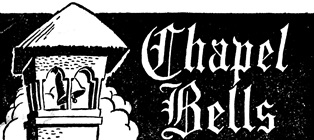
A timid knock on the screen of the chaplain's door, and then entered a young man of medium height, black curly hair, his fatigue suit a bit soiled with grease and oil, his expression indicating deep concern and worry.
"Padre, I can't get my mind on my work lately," he introduced himself rather dejectedly. "There must be a reason for it," the chaplain answered.
"There is Padre. My twin brother is in another theater. We were parted about 14 months ago. This is the first time in our whole life that we have been separated. Neither he nor I are happy over the separation, and I think of him constantly, and it's just no good, Padre."
The chaplain remembered a War Department directive recommending keeping identical twins together and promised the young man that he would investigate the matter immediately. Making inquiries in the front office, the chaplain learned from the adjutant that a request for the reunion of these twins had been previously initiated through channels. A request was forwarded to see what had been done. The answer was a copy of the orders, back-dated, ordering the twin into this theater.
On the following day, the local twin came into the chaplain's office again. The chaplain showed him the copy of the orders and watched the downward crease along the edges of the young man's mouth take a decided upturn. He beamed from ear to ear. He didn't say a word, but his happy expression and brightening eyes definitely spoke: "What a guy, this chaplain of ours. He's on the ball."
There was nothing to do but wait. Perhaps a couple of weeks would tell . . . But "the chaplain was on the ball."
The next night in one of the tents several of the enlisted men were in an interesting bull session, the local twin in their midst. There was a disturbance at the opening of the tent, and in walks a new recruit. The bull-session came to a halt. The local twin had his back to the opening. His companion sitting opposite, his mouth wide open, blurted out in astonishment. From the door to the local twin and back again his eyes kept switching, as he said, "Oh I should have listened to the doctor's advice. He told me that stuff would split my vision..." The Next moment the twins were in each others arms, hugging and yelling.
The next morning, the twins called upon the Padre. The fact assistant of the chaplain answering to the name of "Monsignor" stared in bewilderment. "Padre, two people can't look that much alike, they just can't." The twins just beamed back in defiance, smiling identically.
They measured the same height, to the fraction of an inch, tipping the scale to the pound; their hair bushy, black and curly, even twisted in identical ringlets. With little or no hips, their trousers hung and accentuated the rotund bulge just above the buckle revealing an identical good appetite for GI "vittles." They talked the same, walked the same, and enjoyed the same amusements. To the very keen observer, they offered one distinguishing mark. The original local twin is a corporal, the new delivery a buck private. As per request, both have been assigned to the engineer. They work on the same shift, and both seem to have a common faculty of becoming identically soiled.
The base chaplain, amused over the situation, invited the twins to go with him into the front office. The adjutant was bent busily over a few sheets of paper. He casually looked up and down, and then sat bolt upright. "Gosh!"
The executive officer walked in and excused himself as he started to pass, not looking at anyone too intently. He walked two paces and spun around, staring. "Padre, what is this?" And he rubbed his eyes, with a rapid reflection apparently reassuring him that last evening had nothing to do with the present. He looked more intently, the twins grinning innocently.
The chaplain thought he would relieve the suspense.
"Major, sir, these are two of our boys."
"Yes," blurted the major, "so I- -I see. Now listen here, young men. We are very glad to have you. But don't either of you ever dare to get into trouble." Shaking his head and grunting, the executive officer stormed out of the room. As though we don't have enough trouble around here."
Thus were identical twins welcomed on this base. There is never a dull moment.
- Capt. Harry F. Wade, Chaplain, 1305th BU
|
|
|
In Search, Rescue Work
1333rd BU, ASSAM - An army job doesn't seem so bad when it involves hunting, fishing and swimming, but Lt. William F. Diebold, intelligence officer attached to the Search and Rescue squadron, does these because of necessity. After many jumps into the jungles and long weeks of hiking with a 60-pound pack on his back, the 26 year-old lieutenant has become a jungle veteran.
His first jump occurred within an hour after he arrived at this base for assignment to the squadron, when he participated in the thrilling rescue of Lt. Greenlow M. Collins, a P-51 pilot who went down in one of the Hump's most treacherous areas - the valley of the Gedu. Since then, the "jumping shavetail" has taken part in many other rescues and has compiled a score of adventures which would put a pulp-fiction writer to shame.
Colors for Raft-mate
Snakes often have played their part in providing hair-raising incidents. Once while the lieutenant was leading a group of hillfolk along a jungle path, he barely missed stepping on a krait, one of the most dangerous snakes known. The snake struck the third member of the party, who died within a few moments.
Another time, while Lt. Diebold was alone, paddling down a jungle stream on a raft, a cobra dropped on the raft from a tree overhead. The lieutenant jumped into the water, swam under the raft and came up on the opposite side, only to find himself face to face with the snake again. For an hour and a half he matched wits with the cobra, until he finally managed to ease it off the raft and continue on his way.
On the lighter side, Lt. Diebold relates his experience with a tribe of hillfolk. The village head-man took a liking to him and called all the villagers to meet him. The "shavetail," whose sense of humor rates second only to his love of adventure, taught them the lyrics of "Old MacDonald Had a Farm" - and the chorus of villagers chimed in with "Ee-Ei-Ee-Ei-Oh."
Friend of Tribesmen
By displaying courtesy and thoughtfulness, he has established himself as a friend to jungle tribesmen of the Hump country. On one occasion, one of his village guides, who had been carrying a 100-pound pack of supplies, was overcome by malaria. Lt. Diebold stopped the procession, gave him atabrine and covered him with his own GI blankets.
The "jumping shavetail" still likes to be referred to as such, though he came out of the jungle one day recently and learned he could change the color of his bars from gold to silver. He received the Soldier's medal last month.
|
With Sanction of His CO
1328th BU, ASSAM - T/Sgt. Lucas D. Gonzales probably is not the only GI in Assam who ever made a still but he is one of a few who operate one with the complete sanction of the CO. The reason is that the finished product is water.
Until the recent invention of a water distilling system by Sgt. Gonzales there had been a definite need for distilled water at this base. Sufficient quantities were unobtainable and unprocessed water was being used, causing damage to batteries and a resultant operational handicap.
The new water distilling system solves this problem. Using seven gallons of low octane gasoline, the apparatus piuts out ten gallons of water, enough for three days' operations. The product of Gonzales's device has been tested by the medics and found to be almost 100 percent pure.
Made mostly from salvage materials, the still works on a system of coils, cooling trays and old barrels and is heated with gasoline.
At the beginning Gonzales's greatest difficulty was getting sufficient output. The first model of his still was a small machine which was successful, but did not produce sufficient water. So Gonzales constructed the present unit which distills more than three times as much as is needed.
Gonzales received his technical knowledge at El Paso Technical Institute and the Texas College of Mines. At this base he is NCO in charge of the electrical shop in engineering.
Radio Ops Go To School at Assam Base
Old-timers on Hump Run Serve As Instructors; GI Is Chief
1333rd BU, ASSAM - The Hump route demands from a radio operator all the technical knowledge he can apply. To educate those new to the Hump run, and to aid veteran, a school for aerial radio operators has been established at this base.
Some of the instructors are old-timers who know the Hump's peculiarities. Others are technical experts on a new navigational aid. All are communication specialists and many of them have completed the required operational hours over the division's air lanes. Combined, they offer an intensive course of instruction concerning all the problems encountered in Hump flying.
GIs Instruct
Five instructors teach courses on homings, briefing and routes and continuous wave and voice procedure. They also cover the various types of equipment and their use. Six other specialists give sole attention to the operation of the new navigation receiver.
All functions of the school come under scrutiny of T/Sgt. Julius Ginsberg, chief radio operator, and Sgt. John Weismus, chief instructor. Lt. H. W. Caming, flight communications officer, supervises activities.
Attend Between Flights
Devised and built by the instructors, the gadgets used are unique in that they simulate actual conditions encountered in the air. The school's masterpiece is a mock-up of two radio compasses mounted on a movable platform which enables GIs to demonstrate the use of directional facilities along various routes.
Radio operators here attend the school between flights and are required to have routine checks monthly as well as weekly code checks.
|
Buckeye Sergeants Volunteer Overtime As Hump Radiomen 1330th BU, ASSAM - There's one way of showing the folks back home - and everybody else - how anxious you are to get back to Uncle Sugar, and that's to volunteer for double duty over the Hump. Two Ohio sergeants, Howard A. Behm, of Columbus, and Hugh E. Stanley, of Cleveland, have done it. Behm and Stanley both have accomplished nearly 250 missions, in almost 900 hours of operational flight, as Hump radio operators. Both have received the Air Medal and DFC with one oak leaf cluster each. |
New Show Wows Audience at 1327th;
Pantomimist Stars
1327th BU, ASSAM - A new and original stage show, directed by Sgt. Ely Landau, Brooklyn, and presented to the personnel of this base and nearby hospitals, has all the earmarks of becoming the hit show of 1945 in the theater.
The prize of the show was a pantomime by Sgt. Roy Becker, Milwaukee (see photo section) that left the GIs hysterical with laughter. Not since "Hump Happy" staged its humorous satire has a show received such tumultuous applause, encores and comment.
The cast, composed entirely of 1327th personnel, was personally commended by Lt. Col. Harry Gowins, CO.
Sgt. Becker, under the name of "Roy King," was a feature comedian with "Pappy Trester and the Screwballs," a novelty orchestra, for five years in Minnesota prior to entering the army.
Sgt. Eddie Bauer, Wilkes-Barre, Pa., a professional magician who appeared in the White House on three "command performances" for President and Mrs. Roosevelt, held the audience spellbound with feats of magic.
|
Makes Wrestling Partner
1325th BU, ASSAM - Prowlers around this area would encounter something they didn't bargain for if they tried to enter this domain without being announced.
They would come face to face with a 200-pound Himalayan black bear, who keeps a watchful eye for intruders. With teeth that could cut heavy insulated wire and paws that could crush almost anything, "Blackie" is more than a match for any man - except S/Sgt. John Townsend, of Los Angeles.
Sgt. Townsend, a cook at Assam Wing HQ, befriended Blackie nine months ago when the bear was a two-week old cub. As Blackie grew, the friendship grew and the sergeant became his only companion. Others who dared to enter their sanctuary were met with lashing paws and snarling teeth.
Among Blackie's accomplishments are guzzling beer out of a can, walking on his hind legs, scaring Indians and wrestling with Sgt. Townsend. Standing on his hind legs, in readiness, Blackie awaits the signal and the wrestling match begins. During the bout, the bear makes use of his teeth, gripping the sergeant's arm or leg. Townsend considers this fouling and punches Blackie in the kisser. The bout usually ends with Blackie the victor.
Sgt. Townsend finds this an interesting way to while away the time here. His only regret is that he won't be allowed to take Blackie with him when he returns to the States. The cook is the former owner of the Webster restaurant in Los Angeles and knows a good steak when he sees one.
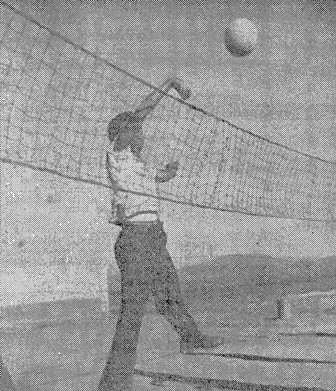 ICD BASE, CHINA - Cpl. E. E. Moor, Dunellen, N.J., radio operator, goes up after a high one on the volleyball court here.
Recently arrived in this theater, Cpl. Moor was surprised to find that he could pursue one of his favorite sports at this forward China base.
He works in the radio section.
ICD BASE, CHINA - Cpl. E. E. Moor, Dunellen, N.J., radio operator, goes up after a high one on the volleyball court here.
Recently arrived in this theater, Cpl. Moor was surprised to find that he could pursue one of his favorite sports at this forward China base.
He works in the radio section.
| Adds Another Sport Inter-department Volleyball League Organized at 1305th 1305th BU, CALCUTTA - Competition in volleyball, softball and basketball is mounting among officers and enlisted men, with volleyball the newest sport to get underway. An Inter-department league consisting of ten teams was organized this week, and the officers' team copped an early lead with three wins. The Weather squadron still holds the lead in the second half of the softball loop, with six wins. Base engineering is in second place, with five victories and one loss; priorities and traffic is third with four wins and two losses. The Skyliners, base cagers, have won one game and lost two in Commandtown competition. They dropped a close 35-30 decision to the MPs, then edged out the strong Camp H quintet by 30 to 24 and bowed in the third tussle to a determined Air Depot five, 52 to 37. Although as yet no tennis courts have been built at Skannal field, officers and enlisted men may sign out equipment for use elsewhere. Officers and enlisted men have also taken part in many golf tournaments in Calcutta. 36 Games Won by ATC Flyers; Ask If They’re Champs 1327th BU - The ATC Flyers, post baseball team, which has won 36 games and lost only eight, has called upon HQ, Calcutta, to determine the championship of India. Cpl. John Shaffer, who is hurling for the Flyers, was the property of the Cincinnati Reds before Uncle Sugar muscled in and picked up an option on his contract. "Lefty" Shaf earned his reputation by winning 18 out of 21 games. Eight of the victories were shut-outs. This is claimed to be a record for the IB and C theaters.
In Oxcart Bowl Classic 1311th BU, INDIA - With Indian urchins running through the stands begging for "baksheesh," the Oxcart Bowl crawled into its proper niche alongside the gridiron extravaganzas of the year as the Station Hospital Medics trounced the 1311th ATC Eagles, 12 to 4, before a wildly enthusiastic, yet confused Sunday crowd of 1,000 of the Indian citizenry. The game was sponsored by the special service office with the entire proceeds donated to the local chapter of the Indian Red Cross. While the crowd never had seen an American football game before and was even more baffled by the six-man touch variety played by the GIs, the spectators cheered every play wildly and left the scene apparent converts of the American fall sport. The Eagles got off to a 2-0 lead in the second period when player-coach Al Salay caught Johnny Carpani, captain of the Medics, behind his own goal line for a safety. The Medics kicked from their own 20-yard line and the Eagles put on their only sustained march of the afternoon, which finally petered out on the enemy's eight yard line. Carpani, Medics star, put his team back into the game as he caught the second-half kickoff and raced 90 yards to a touchdown, weaving his way through the entire ICD team, urged on by the loud "teek-hais" from the stands. Carpani scored again on a long pass in the third quarter, sewing up the game for the hospital. Planters’ Baseball Enters Second Half 1327th BU, ASSAM - The second half of the Tea Planters' Baseball league play at this base opened recently with a record crowd of GIs attending. The ATC Flyers defeated HQ Service Group, 18 to 3, while the QM Harlem Blazers defeated the Blockbusters 9 to 5 and the Service Group Bees triumphed over QM 'B' Co. by 29 to 0.
M/Sgt. Gets Recommendation For Award Before ‘Rotating’ 1327th BU, ASSAM - The life span of a delicate gyro instrument on transport planes has been increased from less than 50 hours to an average of more than 200 hours by an invention of M/Sgt. Carson C. Morse. M/Sgt. Morse, whose home is in Marion, Ohio, was the instrument section chief of this base before he left on rotation for the States. One of the major headaches of the section was trying to keep gyro instruments in repair. They would fail in flight after a few hours, owing to extreme changes in temperature encountered in the run to and from China over the Hump. The average life of the gyro has been stepped up by the use of the pre-heater to more than 200 hours, and in one instance an instrument has been in operation for over 1100 hours. For his achievement, M/Sgt. Morse has been recommended for the Legion of Merit by his commanding officer, Lt. Col. Harry M. Gowins.
Now Shows Pilots Safe Way
P & T Offices Consolidated at Base in Assam Combining of Passenger, Freight Terminal Is Feature Of Setup 1327th BU, ASSAM - The priorities and traffic section here, under the direction of Maj. Fred Strauch, Jr., has undergone a wholesale change in its physical makeup. Formerly located in operations, one mile from its warehouse where trucks had to be dispatched, P & T now has been moved to the runway itself. Here each aspect of its function is in a centralized location. The office, passenger and freight terminals, additional fuel loading ramps, weights and balances, and a repair shop for damaged tie-down equipment are all set up to facilitate quick loading and unloading. Taxi Strips Built Prime benefit of the new location is the ability of incoming and outgoing planes to receive and discharge loads from a ramp adjoining the terminal. Necessary taxi strips were constructed for the purpose. Transient Facilities In keeping with centralization is the nearly-completed modern passenger terminal calculated to suit the most discriminating taste. Set off by the striking mural work of Lt. Nicolai V. Kuvshinoff, a prominent pre-war artist, this room will boast indirect lighting, rugs, writing desks, lounge chairs and magazine racks. Passenger planes, like cargo ships, discharge their loads at this consolidated freight-passenger terminal, enabling transients to obtain quicker transportation to billeting and mess facilities. In the event time does not permit leaving the terminal, passengers will be supplied K rations and fruit juices. HUMP EXPRESS is the official newspaper of the India-China Division, Air Transport Command, APO 192, c/o Postmaster, New York, N.Y., and is published by its Public Relations office. Camp Newspaper Service and Army Newspaper Service features are used, reproduction of which is prohibited without permission of CNS and ANS, 205 East 42nd St., New York, 17, N.Y. Other material is submitted by staff members, ICD-ATC base Public Relations sections and other soldier correspondents. Printed weekly by the Hindusthan Standard, 3 Burman St., Calcutta, India, and distributed each Thursday. Passed by U.S. Press Censor for mailing.

FEBRUARY 1, 1945 Original issue of HUMP EXPRESS scanned and photographed by Bill Stanley Copyright © 2020 Carl Warren Weidenburner TOP OF PAGE PRINT THIS PAGE ABOUT THIS PAGE E-MAIL YOUR COMMENTS PREVIOUS ISSUE HUMP EXPRESS BASE NEXT ISSUE
|
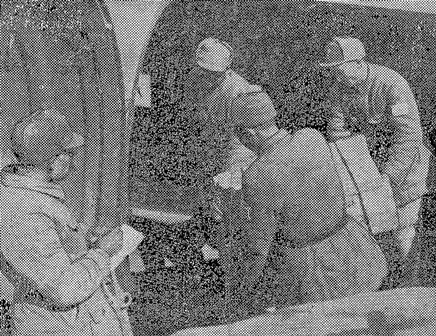 The first planeload in the Yenan medical supply mission is unloaded. Included were sulfa drugs, surgical instruments and many other items, brought over
a rugged route with but unserviceable check point.
The first planeload in the Yenan medical supply mission is unloaded. Included were sulfa drugs, surgical instruments and many other items, brought over
a rugged route with but unserviceable check point.
 The task of keeping scores of Jap weapons turned in to the I & S office at the 1333rd falls to S/Sgt. Glenn Kettner.
After the weapons are checked they are soon on their way to the States via mail. They are top-notch as souvenirs.
The task of keeping scores of Jap weapons turned in to the I & S office at the 1333rd falls to S/Sgt. Glenn Kettner.
After the weapons are checked they are soon on their way to the States via mail. They are top-notch as souvenirs.
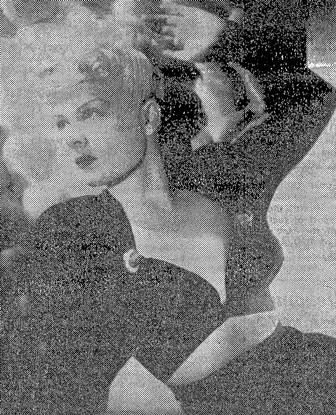 Whozit? Your guess is as good as ours. We ran the photo up and down the aisles at HQ, asking guys who ought to know. "Nay malum," was the chief reply
obtained. All we know is that our pinup for the week is a Paramount star, but the press agent neglected to name her. Some say she's Betty Hutton; others
Jane Wyman. We say she's gorgeous.
Whozit? Your guess is as good as ours. We ran the photo up and down the aisles at HQ, asking guys who ought to know. "Nay malum," was the chief reply
obtained. All we know is that our pinup for the week is a Paramount star, but the press agent neglected to name her. Some say she's Betty Hutton; others
Jane Wyman. We say she's gorgeous.
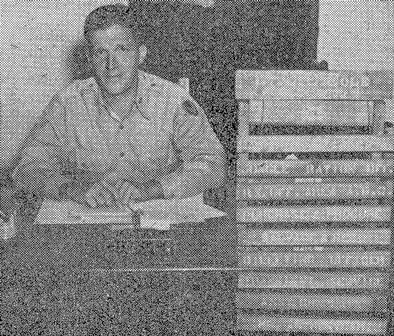 Lt. C. E. Cole peeks out from behind his ten signs, eight of which are pukka.
Lt. C. E. Cole peeks out from behind his ten signs, eight of which are pukka.
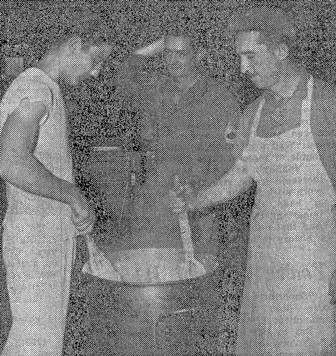 1347th BU, INDIA - The perplexed look on T/Sgt. Westell Malone's face is genuine. A mess sergeant he runs into double trouble distinguishing between the two
cooks on either side of him. Left is Pvt. William A. Davis and on the right is Pvt. William A. Davis. Besides identical names the two have the same MOS and
are in the same outfit. How about working them different shifts?
1347th BU, INDIA - The perplexed look on T/Sgt. Westell Malone's face is genuine. A mess sergeant he runs into double trouble distinguishing between the two
cooks on either side of him. Left is Pvt. William A. Davis and on the right is Pvt. William A. Davis. Besides identical names the two have the same MOS and
are in the same outfit. How about working them different shifts?

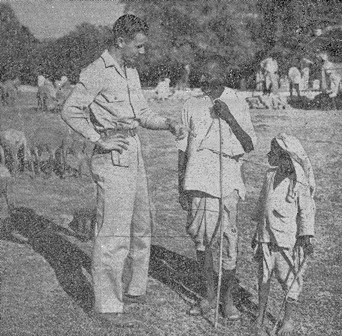 Yes, it is his son, the shepherd falteringly answers Sgt. Howard J. Kleinsmith, Reading, Pa. (Sheep on ICD bases are welcome landmowers.)
Yes, it is his son, the shepherd falteringly answers Sgt. Howard J. Kleinsmith, Reading, Pa. (Sheep on ICD bases are welcome landmowers.)
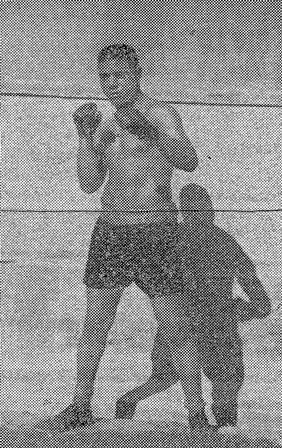 Pvt. Jesse Dean, ICD heavyweight, claims all-India crown after defeating another GI who had beaten civilian champion.
Pvt. Jesse Dean, ICD heavyweight, claims all-India crown after defeating another GI who had beaten civilian champion.
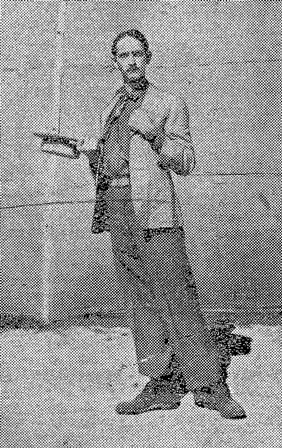 Known as "Roy King" in pre-army days, Sgt. Roy Becker of Milwaukee wows them in the Valley as comic of hot GI show.
Known as "Roy King" in pre-army days, Sgt. Roy Becker of Milwaukee wows them in the Valley as comic of hot GI show.
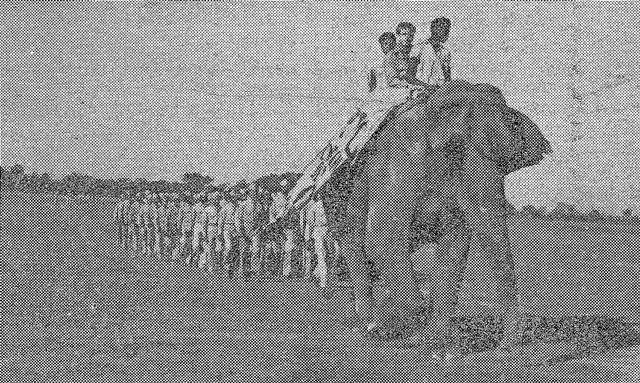 Welcoming the popular and girly USO Show Unit 269, one valley station put on a terrific display of ballyhoo and buncombe, culminating in a mass formation
led by this pachydermic super-drum-major.
Welcoming the popular and girly USO Show Unit 269, one valley station put on a terrific display of ballyhoo and buncombe, culminating in a mass formation
led by this pachydermic super-drum-major.
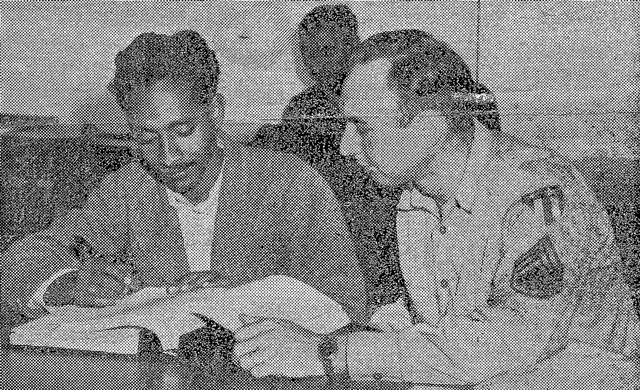 To Sudhendra Ray (left) his boss is S/Sgt. Herbert J. Richter, but to home folks in Conger, Ga., he's still "Mr. Mayor."
Entering the army in 1942, he was succeeded in office by rival he had defeated.
To Sudhendra Ray (left) his boss is S/Sgt. Herbert J. Richter, but to home folks in Conger, Ga., he's still "Mr. Mayor."
Entering the army in 1942, he was succeeded in office by rival he had defeated.
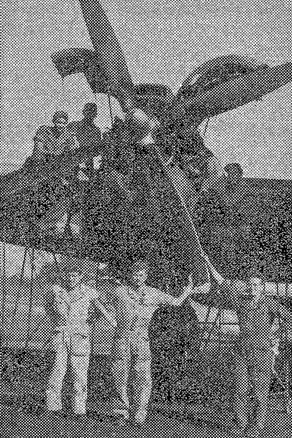 Broke crewing record on 1328th's "Banner Day": (above) Cpl. Hays, Pfc. Brown, Sgt. Dryer; (below) Cpls. Hutchinson and Hawkins, Sgt. Pemberton.
Broke crewing record on 1328th's "Banner Day": (above) Cpl. Hays, Pfc. Brown, Sgt. Dryer; (below) Cpls. Hutchinson and Hawkins, Sgt. Pemberton.
 For first time in 3 years, brothers meet in ICD. Sgt. Dick Blue and T/4 Glen Blue met last when Dick was a civilian, Glen a two-month rookie, back in the U.S.
For first time in 3 years, brothers meet in ICD. Sgt. Dick Blue and T/4 Glen Blue met last when Dick was a civilian, Glen a two-month rookie, back in the U.S.
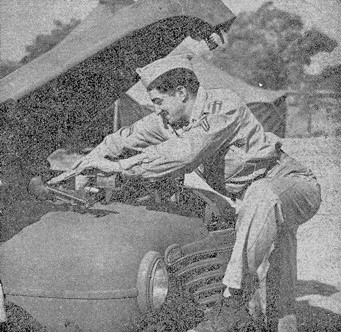 Rochester, N.Y., sports fans recall "Jimmy Fox," Airport stadium stunt man and race driver. Now he's Sgt. George Coccia, ICD motorpooler.
Rochester, N.Y., sports fans recall "Jimmy Fox," Airport stadium stunt man and race driver. Now he's Sgt. George Coccia, ICD motorpooler.
 Search and Rescue squadron's "jumping shavetail." Lt. William F. Diebold, is ready to leave on another mission into Hump jungle.
His only peeve was the photographer's request to look towards the camera and smile just as he was leaving the plane and before opening the 'chute.
Search and Rescue squadron's "jumping shavetail." Lt. William F. Diebold, is ready to leave on another mission into Hump jungle.
His only peeve was the photographer's request to look towards the camera and smile just as he was leaving the plane and before opening the 'chute.
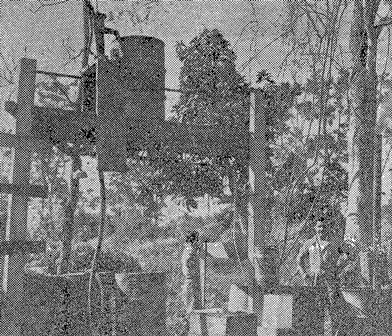 This could be a Kentucky moonshiner's hangout but it's a water distiller at the 1328th in Assam, which furnishes distilled water for batteries.
Here T/Sgt. Lucas D. Gonzales and his Indian assistant run off a batch.
This could be a Kentucky moonshiner's hangout but it's a water distiller at the 1328th in Assam, which furnishes distilled water for batteries.
Here T/Sgt. Lucas D. Gonzales and his Indian assistant run off a batch.
 Search and Rescue squadron's "jumping shavetail." Lt. William F. Diebold, is ready to leave on another mission into Hump jungle.
His only peeve was the photographer's request to look towards the camera and smile just as he was leaving the plane and before opening the 'chute.
Search and Rescue squadron's "jumping shavetail." Lt. William F. Diebold, is ready to leave on another mission into Hump jungle.
His only peeve was the photographer's request to look towards the camera and smile just as he was leaving the plane and before opening the 'chute.
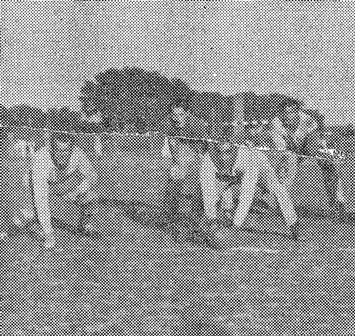 They lost the Oxcart bowl game to the Station hospital, but it was for a worthy cause - the Indian Red Cross. members of the ATC Eagles, representing
the 1311th were Pfc. Joe Polinsky of Fairport, Ohio; S/Sgt. Frank Kesser of Newark, N.J.; Pfc. Donald R. Case of Edson, Kans.; Pfc. Charles Riggles,
Greenwood, Ind.; Sgt. Al Salay, coach from Buffalo, N.Y. and Cpl. Jack Maddox of Experiment, Ga.
They lost the Oxcart bowl game to the Station hospital, but it was for a worthy cause - the Indian Red Cross. members of the ATC Eagles, representing
the 1311th were Pfc. Joe Polinsky of Fairport, Ohio; S/Sgt. Frank Kesser of Newark, N.J.; Pfc. Donald R. Case of Edson, Kans.; Pfc. Charles Riggles,
Greenwood, Ind.; Sgt. Al Salay, coach from Buffalo, N.Y. and Cpl. Jack Maddox of Experiment, Ga. 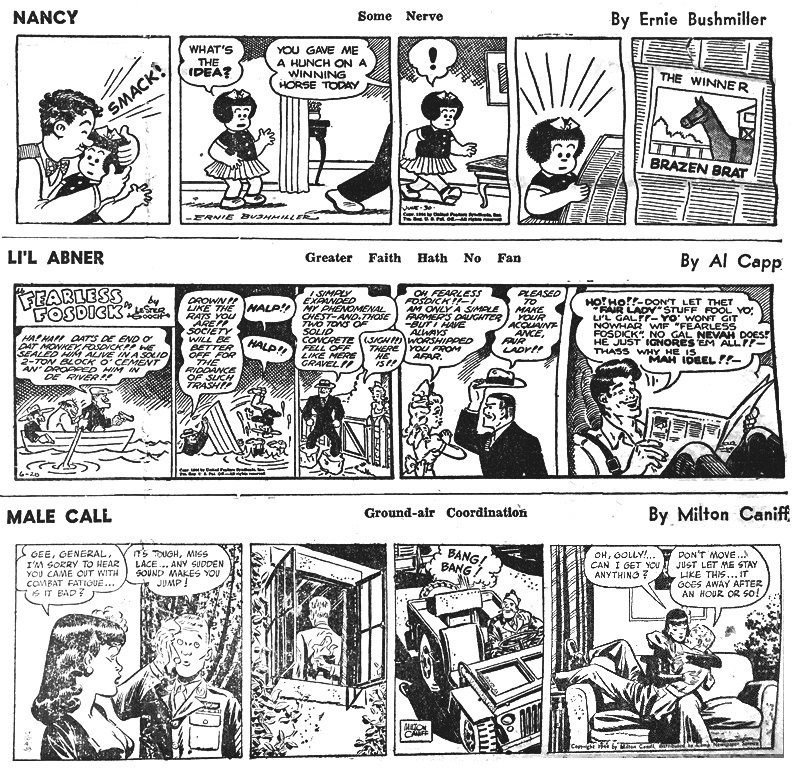
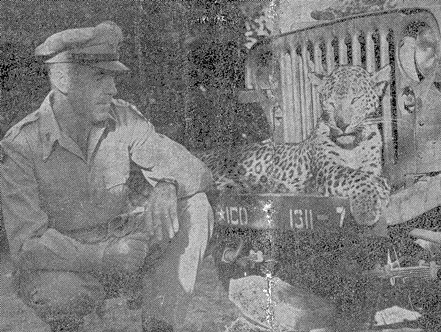 The eyes are open, but the big cat isn't alive. Bagged in a hunt near the 1311th, he lies on the jeep of his killer, Lt. Col. Lee L. Willey.
A veteran sportsman, the colonel calls the neighborhood of his field "one of the best hunting spots in the world."
The eyes are open, but the big cat isn't alive. Bagged in a hunt near the 1311th, he lies on the jeep of his killer, Lt. Col. Lee L. Willey.
A veteran sportsman, the colonel calls the neighborhood of his field "one of the best hunting spots in the world."
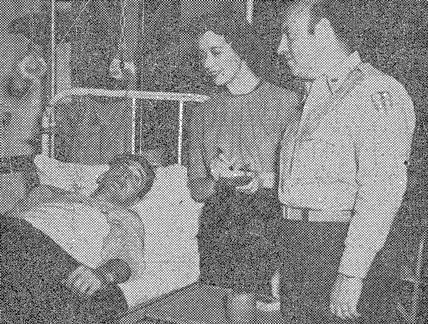 A soldier who received an ironic injury gets an autograph from an illustrious singer. Lily Pons and Andre Kostelanetz dropped in to see Pfc. Otis Lee Dobyns,
of Golden, Colo., hospitalized at the 1330th BU, and left their autographs.
A soldier who received an ironic injury gets an autograph from an illustrious singer. Lily Pons and Andre Kostelanetz dropped in to see Pfc. Otis Lee Dobyns,
of Golden, Colo., hospitalized at the 1330th BU, and left their autographs.
